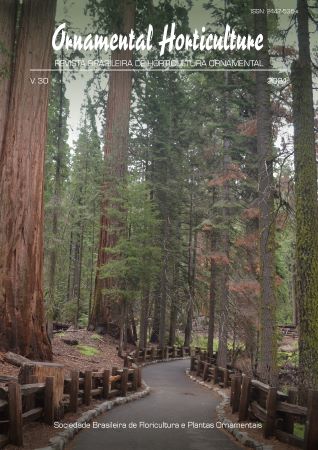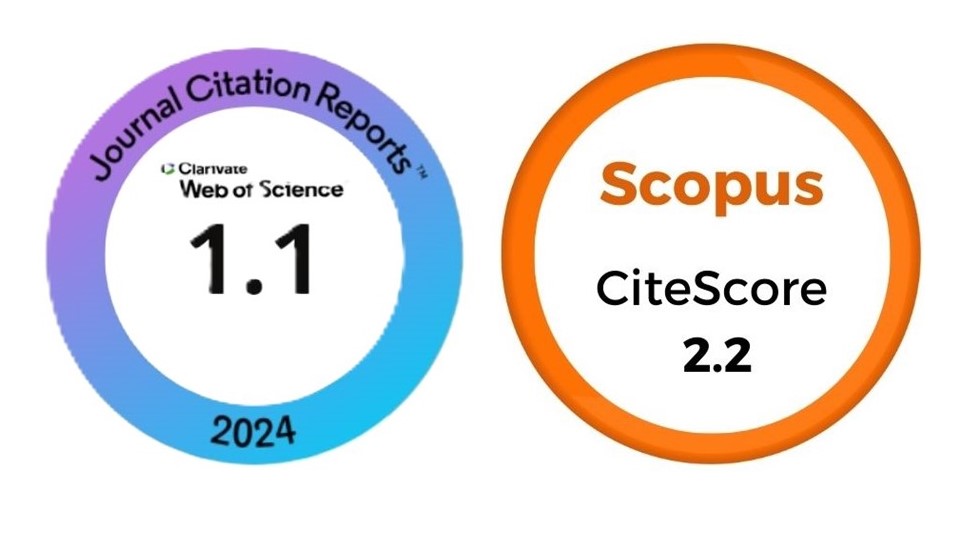Effect of calcium chloride and salicylic acid on some morphological, biochemical and postharvest properties of alstroemeria cut flowers ‘Orange Queen’
DOI:
https://doi.org/10.1590/2447-536X.v30.e242697Keywords:
malondialdehyde, number of florets, photosynthetic pigments, postharvest qualityAbstract
This study investigated the impact of varying calcium chloride (CaCl2) and salicylic acid (SA) concentrations on the growth, biochemical, and postharvest quality of Alstroemeria ‘Orange Queen’ flowers. A completely randomized factorial design (CRD) with two factors and three replications was employed. The first factor involved foliar application of 0, 75, 150, or 225 mg L-¹ CaCl2, while the second factor consisted of 0, 150, 300, or 450 mg L-¹ SA. Morphological characteristics (number of leaves, leaf fresh and dry weight, number of florets) and biochemical parameters (photosynthetic pigment content, soluble sugar content) were evaluated. Additionally, postharvest traits (relative fresh weight, relative solution uptake, malondialdehyde content, catalase and ascorbate peroxidase activity) were assessed. The highest fresh and dry weights and the greatest number of florets were observed in Alstroemeria treated with 225 mg L-¹ CaCl and 450 mg L-¹ SA. This combination also improved the flowers’ postharvest quality. Photosynthetic pigment content was significantly enhanced by both CaCl2 and SA, while malondialdehyde content was reduced compared to the control. Antioxidant enzyme activity was significantly increased following the application of CaCl and SA. Foliar application of 225 mg L ¹ CaCl and 450 mg L-¹ SA promoted the growth, biochemical composition, and postharvest quality of Alstroemeria ‘Orange Queen’ flowers. This treatment improved flower size, number, and enhanced their resistance to stress, suggesting its potential for enhancing the commercial value of this cultivar.
Downloads
References
AEBI, H. Catalase in vitro. Methods in Enzymology, v.105, p.121-126, 1984. https://doi.org/10.1016/s0076-6879(84)05016-3
AFZAL, S.; CHAUDHARY, N.; SINGH, N.K. Role of soluble sugars in metabolism and sensing under abiotic stress. In: AFTAB, T., HAKEEM, K.R. (eds). Plant Growth Regulators. Cham.: Springer, 2021.
ALI, S.; GANAI, B.A.; KAMILI, A.N.; BHAT, A.A.; MIR, Z.A.; BHAT, J.A.; TYAGI, A.; ISLAM S.T.; MUSHTAQ M.; YADAV, P.; RAWAT, S.; GROVER, A. Pathogenesis-related proteins and peptides as promising tools for engineering plants with multiple stress tolerance. Microbiological Research, v.29, p. 212-213. 2018. https://doi.org/10.1016/j.micres.2018.04.008
BARKER, V.A.; PILBEAM, J.D. Handbook of Plant Nutrition. Boca Raton: CRC Press, Taylor and Francis Group, 2007.
CAKMAK, I.; HORST, W.J. Effect of aluminum on lipid peroxidation, superoxide dismutase, catalase, and peroxidase activities in root tips of soybean (Glycine max). Physiologia Plantarum, v.83, n.3, p.463-468, 1991. https://doi.org/10.1111/j.1399-3054.1991.tb00121.x
EL-SERAFY, R.S. Silica nanoparticles enhance physio-biochemical characters and postharvest quality of Rosa hybrida L. cut flowers. Journal of Horticultural Research, v.27, n.1, p.47-54, 2019. https://doi.org/10.2478/johr-2019-0006
GUO, Y.; LIU, Y.; ZHANG, Y.; LIU, J.; GUL, Z.; GUO, X.-R.; ABOZEID, A.; TANG, Z.-H. Effects of exogenous calcium on adaptive growth, photosynthesis, ion homeostasis and phenolics of Gleditsia sinensis Lam. plants under salt stress. Agriculture, v.11, p.978, 2021. https://doi.org/10.3390/agriculture11100978
GUPTA, D.K.; PALMA, J.M. CORPAS, F.J. Nitric oxide and hydrogen peroxide signaling in higher plants. Berlin: Springer, 2019. 275p.
IRIGOYEN, J.J.; EMERICH, D.W.; SANCHEZ-DIAZ, M. Water stress induced changes in concentrations of proline and total soluble sugars in nodulated alfalfa (Medicago sativa) plants. Physiologia Plantarum, v.84, p.55-60, 1992. https://doi.org/10.1111/j.1399-3054.1992.tb08764.x
KANG, H.M.; SALTVEIT, M.E. Chilling tolerance of maize, cucumber and rice seedling leaves and roots and differentially affected by salicylic acid. Plant Physiology, v.115, p.571-576, 2002. https://doi.org/10.1034/j.1399-3054.2002.1150411.x
KHANDAN-MIRKOHI, A.; PIRGAZI, R.; TAHERI, M.R.; AJDANIAN, L.; BABAEI, M.; JOZAY, M.; HESARI, M. Effects of salicylic acid and humic material preharvest treatments on postharvest physiological properties of statice cut flowers. Scientia Horticulturae, v. 283, p.110009, 2021. https://doi.org/10.1016/j.scienta.2021.110009
KHOLDEBARIN, B.; ESLAMZADEH, T. Mineral nutrition of plants (Vol. 1). Shiraz: Shiraz University Pub., 2001. pp.358-360. (in Persian)
KHORSHIDI, R.; JOKAR, A.; GOLMAKANI, M.T. The effect of foliar spraying of salicylic acid and potassium sulfate on quality and quantity of Pelargonium graveolens. Journal of Plant Research (Iranian Journal of Biology), v.32, n.1, p.1-8, 2019. (in Persian)
KLESSIG, D.F.; CHOI, H.W.; DEMPSEY, D.A. Systemic acquired resistance and salicylic acid: past, present, and future. Molecular Plant- Microbe Interactions, v.31, p.871-888, 2018. https://doi.org/10.1094/MPMI-03-18-0067-CR
KORVER, R.A.; KOEVOETS, I.T.; TESTERINK, C. Out of shape during stress: a key role for auxin. Trends in Plant Science, v.23, p.783-793, 2018. https://doi.org/10.1016/j.tplants.2018.05.011
LICHTENTHALER, H.K. Chlorophylls and carotenoids: pigments of photosynthetic biomembranes. Methods in Enzymology, v.148, p.350- 382, 1987. https://doi.org/10.1016/0076-6879(87)48036-1
LUO, Y.; LIU, M.; CAO, J.; CAO, F.; ZHANG, L. The role of salicylic acid in plant flower development. Forestry Research, v.2, p.14-20, 2022. https://doi.org/10.48130/FR-2022-0014
MADY, E.; ABD El-WAHED, A.H.M.; AWAD, A.H.; ASAR, T.O.; AL- FARGA, A.; ABD EL-RAOUF, H.S.; RANDHIR, R.; ALNUZAILI, E.S.; EL-TAHER, A.M.; RANDHIR, T.O.; HAMADA, F.A. Evaluation of salicylic acid effects on growth, biochemical, yield, and anatomical characteristics of eggplant (Solanum melongena L.) plants under salt stress conditions. Agronomy, v.13, n.9, p.2213, 2023. https://doi.org/10.3390/agronomy13092213
MIRZAIE ESGANDIAN, N.; JABBARZADEH, Z.; RASOULI-SADAGHIANI, M.H. Investigation of some morphological and biochemical characteristics and vase life of Gerbera jamesonii cv. Dune cut flower using humic acid and nano calcium chelate. Iranian Journal of Horticultural Science and Technology, v.20, n.2, p.157-170, 2019. (in Persian)
MOALLAYE MAZAEI, S.; CHEHRAZI, M.; KHALEGHI, E. The effect of calcium nanochelate on morphological, physiological, biochemical characteristics and vase life of three cultivars of gerbera under hydroponic system. Plant Productions, v.43, n.1, p.53-66, 2020. (in Persian)
NAKANO, Y.; ASADA, K. Hydrogen peroxide is scavenged by ascorbate specific peroxidase in spinach chloroplasts. Plant Cell Physiology, v.22, p.867-880, 1981. https://doi.org/10.1093/oxfordjournals.pcp.a076232
NASERI, M.T.; EBRAHIMI GERAVI, M. Physiology of bulbous plants. Mashhad: Jahad Daneshgahi of Mashhad press, 2002. 352p. (in Persian)
NAZARI, F. The effect of foliar application of calcium chloride and nanocalcium chelated on vegetative, reproductive and post-harvest life of tuberose (Polianthes tuberosa L.). Journal of Plant Research, v.32, n.2, p.1-14, 2019. (in Persian)
NOUSIS, L.; KANAVAROS, P.; BARBOUTI, A. Oxidative stress-induced cellular senescence: is labile iron the connecting link? Antioxidants, v.12, n.6, p.1250, 2023. https://doi.org/10.3390/antiox12061250
PASTERNAK, T.; GROOT, E.P.; KAZANTSEV, F.V.; TEALE, W.; OMELYANCHUK, N.; KOVRIZHNYKH, V.; PALME, K.; MIRONOVA, V.V. Salicylic acid affects root meristem patterning via auxin distribution in a concentration-dependent manner. Plant Physiology, v.180, p.1725- 1739, 2019. https://doi.org/10.1104/pp.19.00130
PEREZ-LLORCA, M.; MUNOZ, P.; MULLER, M.; MUNNE-BOSCH, S. Biosynthesis, metabolism and function of auxin, salicylic acid and melatonin in climacteric and non-climacteric fruits. Frontiers in Plant Science, v.10, n.136, p.1-10, 2019. https://doi.org/10.3389/fpls.2019.00136
REDDY, A.R.G.; SARKAR, M.M. Effect of calcium on Gladiolus. Charlottesville: Lambert Press, 2016. 60p.
RUAMRUNGSRI, S.; INKHAM, C. Effect of calcium nitrate addition on growth and bulb quality of Hippeastrum. Acta Horticulturae, v.54, n.1167, p.375-380, 2017. https://doi.org/10.17660/ActaHortic.2017.1167.54
SALEEM, M.; FARIDUDDIN, Q.; CASTROVERDE, C.D.M. Salicylic acid: A key regulator of redox signaling and plant immunity. Plant Physiology and Biochemistry, v.168, p.381-397, 2021. https://doi.org/10.1016/j.plaphy.2021.10.011
SHAHMORADI, H.; NADERI, D. Improving effects of salicylic acid on morphological, physiological and biochemical responses of salt-imposed winter jasmine. International Journal of Horticultural Science and Technology, v.5, n.2, p.219-230, 2018. https://doi.org/10.22059/ijhst.2018.259507.246
SHAKIROVA, M.F.; SAKHABUTDINOVA, A.R.; BEZRUKOVA, M.V.; FATKHUTDINOVA, R.A.; FATKHUTDINOVA, D.R. Change in the hormonal status of wheat seedling induced by salicylic acid and salinity. Journal of Plant Science, v.164, n.3, p.317-322, 2003. https://doi.org/10.1016/S0168-9452(02)00415-6
TABATABAIE, J. Principles of mineral nutrition of plants. Tabriz: Tabriz University Press, 2014. 652p. (in Persian)
TOFIGHI ALIKHANI, T.; TABATABAEI, S.J.; MOHAMMADI TORKASHVAND, A.; TALEI, D. Silica nanoparticles and calcium on the histological characteristics and stem bending in gerbera cut flower. Ornamental Horticulture, v.27, n.3, p.334-343, 2021. https://doi.org/10.1590/2447-536X.v27i3.2308
VLOT, A.C.; DEMPSEY, M.A.; KLESSIG, D.F. Salicylic acid, a multifaceted hormone to combat disease. Annual Reviews of Phytopathology, v.47, p.177-206, 2009. https://doi.org/10.1146/annurev.phyto.050908.135202
WANG, K.; SHENG, Y.; WANG, H.; HE, S.; KIM, W.S.; SHANG, W.; WANG, Z.; SHI, L. Effects of exogenous salicylic acid (SA), 6-benzylaminopurine (6-BA), or abscisic acid (ABA) on the physiology of Rosa hybrida ‘Carolla’ under high-temperature stress. Horticulturae, v.8, n.9, p.851, 2022. https://doi.org/10.3390/horticulturae8090851
ZAMANI, S.; KAZEMI, M.; ARAN, A. Postharvest life o Rose flowers as affected by salicylic acid and glutamine. World Applied Science Journal, v.12, n.9, p.1621-1624, 2011.
Downloads
Published
Issue
Section
License
Copyright (c) 2024 Ornamental Horticulture

This work is licensed under a Creative Commons Attribution 4.0 International License.








